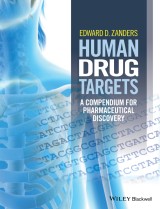Details

Human Drug Targets
A Compendium for Pharmaceutical Discovery1. Aufl.
|
108,99 € |
|
| Verlag: | Wiley-Blackwell |
| Format: | |
| Veröffentl.: | 14.12.2015 |
| ISBN/EAN: | 9781118849835 |
| Sprache: | englisch |
| Anzahl Seiten: | 456 |
DRM-geschütztes eBook, Sie benötigen z.B. Adobe Digital Editions und eine Adobe ID zum Lesen.
Beschreibungen
<p>The identification of drug targets in a given disease has been central to pharmaceutical research from the latter half of the 20th century right up to the modern genomics era. Human Drug Targets provides an essential guide to one of the most important aspects of drug discovery – the identification of suitable protein and RNA targets prior to the creation of drug development candidates.</p> <p>The first part of the book consists of introductory chapters that provide the background to drug target discovery and highlight the way in which these targets have been organised into online databases. It also includes a user’s guide to the list of entries that forms the bulk of the book.</p> <p>Since this is not designed to be a compendium of drugs, the emphasis will be on the known (or speculated) biological role of the targets and not on the issues associated with pharmaceutical development. The objective is to provide just enough information to be informative and prompt further searches, while keeping the amount of text for each of the many entries to a minimum.</p> <p><i>Human Drug Targets</i> will prove invaluable to those drug discovery professionals, in both industry and academia, who need to make some sense of the bewildering array of online information sources on current and potential human drug targets. As well as creating order out of a complex target landscape, the book will act as an ideas generator for potentially novel targets that might form the basis of future discovery projects. </p>
Preface vii <p><b>Chapter 1 Introduction 1</b></p> <p>1.1 Magic bullets 1</p> <p>1.2 Background to modern pharmacology 2</p> <p>1.2.1 The receptor theory 3</p> <p>1.2.2 Molecular pharmacology 4</p> <p>1.2.3 Receptors, signals and enzymes 4</p> <p>1.2.4 Recombinant DNA technology and target discovery 5</p> <p>1.3 Drug and therapeutic targets in the biomedical literature 5</p> <p>1.4 How many drug targets are there? 5</p> <p>1.4.1 Systematic target discovery 6</p> <p>1.5 Screening for active molecules 7</p> <p>References 9</p> <p><b>Chapter 2 Overview of the drug target compendium 11</b></p> <p>2.1 Introductory comments 11</p> <p>2.2 Selection of entries 12</p> <p>2.2.1 Gene name and symbol 12</p> <p>2.2.2 Drug/investigational compound name 12</p> <p>2.2.3 Literature reference 13</p> <p>2.2.4 Involvement in disease 14</p> <p>2.3 Organization of entries 15</p> <p>2.3.1 Cell surface and secreted proteins 16</p> <p>2.3.2 Enzymes 16</p> <p>2.3.3 Entries classified by subcellular location 17</p> <p>2.3.4 Non?]coding RNAs 18</p> <p>2.4 Summary of data entries 18</p> <p>2.5 How to use this book 19</p> <p>2.6 Final comments 21</p> <p>References 21</p> <p><b>Chapter 3 Cell surface and secreted proteins 23</b></p> <p>3.1 G?]protein?]coupled receptors (GPCRs) 24</p> <p>3.1.1 G?]protein?]coupled receptor (GPCR) ligands 39</p> <p>3.2 Nuclear hormone receptors (NHRs) 43</p> <p>3.3 Cytokines and receptors 45</p> <p>3.4 Adhesion molecules 64</p> <p>3.5 Host defence molecules 75</p> <p>3.6 Transporters and channels 90</p> <p>3.6.1 ATP?]binding cassette families and transporting ATPases 90</p> <p>3.6.2 Solute carrier (SLC) families 96</p> <p>3.6.3 Ligand?]gated ion channels 112</p> <p>3.6.4 Voltage?]gated ion channels 116</p> <p>3.6.5 Assorted transport and carrier proteins 128</p> <p><b>Chapter 4 Enzymes: Part 1 135</b></p> <p>4.1 Signalling enzymes 136</p> <p>4.1.1 Protein kinases 136</p> <p>4.1.2 Protein phosphatases 160</p> <p>4.1.3 Cyclic nucleotides and phosphodiesterases 168</p> <p>4.1.4 GTPase signalling proteins 170</p> <p>4.1.5 Other signalling enzymes 176</p> <p>4.2 Protein modification 179</p> <p>4.2.1 Peptidases 179</p> <p>4.2.1.1 Peptidase inhibitors 202</p> <p>4.2.2 Glycosylation 208</p> <p>4.2.3 Ubiquitylation and related modifications 218</p> <p>4.2.4 Chromatin modification 230</p> <p>4.2.5 Protein synthesis and folding 236</p> <p>4.2.6 Other protein modifications 241</p> <p><b>Chapter 5 Enzymes: Part 2 247</b></p> <p>5.1 Lipids and related 248</p> <p>5.2 Amino acids and related 267</p> <p>5.3 Nucleotides and related 276</p> <p>5.4 Carbohydrates and related 282</p> <p>5.5 Vitamins, cofactors and related 293</p> <p>5.6 DNA?]processing enzymes 296</p> <p>5.7 RNA?]processing enzymes 304</p> <p>5.8 Stress response and homeostasis 316</p> <p>5.9 Miscellaneous enzymes 330</p> <p><b>Chapter 6 Remaining annotated entries grouped by subcellular location 335</b></p> <p>6.1 Cell surface and secreted proteins 335</p> <p>6.2 Cytoskeleton 356</p> <p>6.3 Cytoplasm to nucleus 364</p> <p>6.4 Nucleus 375</p> <p>6.5 Internal membranes and organelles 400</p> <p>6.6 Cytoplasmic proteins 417</p> <p>6.7 Subcellular location not annotated 424</p> <p><b>Chapter 7 Non?-Coding RNAs 437</b></p>
<p><b>Dr Edward Zanders, </b>PharmaGuide Ltd<b>, </b>Cambridge, UK.</p>


















